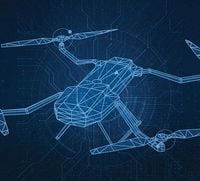On October 20, 2025, the landscape of military readiness and national security is being reshaped by a force that, until recently, seemed the stuff of science fiction: artificial intelligence. According to Breaking Defense and IPDForum, the United States is not only embracing AI across its defense infrastructure but racing to stay ahead of global competitors like China and Russia. The integration of AI into military modeling and simulation (M&S), operations, and even nuclear command is transforming how wars are prepared for—and, potentially, how they will be fought.
At the heart of this transformation are partnerships between industry giants such as CAE, a leader in military training systems, and General Atomics, known for its cutting-edge aerospace platforms. Their collaboration is yielding AI-powered M&S tools that make training more realistic and efficient. As Breaking Defense reports, AI algorithms now populate virtual training environments with sophisticated computer-generated forces. Unlike the predictable, almost robotic adversaries of past simulations, these AI entities can act as well-trained teammates or cunning opponents, adapting to the trainee's every move. This shift reduces the need for large numbers of personnel in exercises, slashes logistical costs, and allows for more hours of focused training.
Brian Stensrud, technical fellow for artificial intelligence at CAE USA Defense & Security, explained, "The promise of AI is that I can use that to build models of behavior to serve as opponent forces and teammates at varying levels of complexity. Now I can train one operator or student with a far smaller footprint of entities, which saves time, it saves on logistics, and it certainly saves on dollars." The net effect? AI-powered training becomes a true force-multiplier, scaling to support more servicemembers without sacrificing quality or realism.
But the benefits don’t stop at training. For General Atomics, these AI-driven simulations provide a testbed for new drone capabilities, allowing engineers to run countless iterations without the expense or risk of actual flight tests. Anastacia MacAllister, technical director for autonomy and AI at General Atomics, emphasized, "AI/ML is ready; it’s here to stay. We just need to make sure we’re using the right tool for the right job and ensuring that we understand the technology we’re using and the questions we’re asking it to answer. That way we can make sure we use it in an effective manner."
The military’s embrace of AI extends well beyond simulated battlefields. As IPDForum details, the Department of War (DOW) is deploying AI in communications networks, autonomous vehicles, logistics, intelligence, and cyber defense. The goal? To enable warfighters—across all branches—to make quicker, more accurate decisions, often in real time, and to outmaneuver adversaries with unprecedented agility. AI’s reach even extends to satellite imagery: predictive models can now help pinpoint locations where security threats, such as the deployment of weapons of mass destruction, may arise. William Marshall, CEO of Planet Labs, told Defense One, "In principle, generative AI models … can leverage satellite data to predict what is likely to happen: 'You’re likely to have a drought here that might lead to civil unrest.'"
The U.S. has been laying the groundwork for this AI revolution for years. Project Maven, launched in 2017, was an early effort to use AI for automatic target identification on the battlefield. The Department of War’s 2018 National Defense Strategy identified AI as a cornerstone of future military success. Today, AI is being integrated into the nuclear command, control, and communications enterprise of U.S. Strategic Command (USSTRATCOM). As Gen. Anthony Cotton, USSTRATCOM Commander, put it, "Advanced AI and robust data analytics capabilities provide decision advantage and improve our deterrence posture. IT and AI superiority allows for more effective integration of conventional and nuclear capabilities, strengthening deterrence."
Despite the power of these technologies, military leaders are quick to stress that humans remain firmly in control. Vice Adm. Brad Cooper, deputy commander of U.S. Central Command, reassured a gathering of defense leaders, "Everything we do has a human in the loop. At the end of the day, decisions are made by humans. It’s the decision-making process that is more vibrantly enabled through AI. We’re able to move at speeds that were previously unimaginable." This philosophy is echoed in the design of training tools by CAE, which is developing an "omnipresent" AI observer. This digital assistant catalogs trainee actions, assesses them, and delivers tailored feedback—empowering both instructors and students, but never supplanting human judgment.
Of course, the effectiveness of AI hinges on the quality of the data it consumes. CAE’s machine learning algorithms sift through massive datasets from training platforms, seeking patterns that reveal systemic issues—such as a persistent struggle with a particular skill—so curricula can be improved. But as MacAllister warns, "What we see is that people think that quantity equals quality, when it doesn’t. Companies should instead treat data not necessarily as exhaust from our process, but should understand it as a resource that is going to drive the engine." The right data, paired with the right algorithms, lets warfighters hone tactics and procedures before facing real-world threats.
Yet, as the U.S. pushes forward, it faces stiff competition. In 2017, China announced its intention to lead the world in AI by 2030, and Russia soon followed with its own ambitions. U.S. Sen. John Hickenlooper, speaking at a Center for Strategic and International Studies panel, noted, "China is investing a 'staggering' amount of resources into building the country’s AI capabilities." Still, he expressed confidence in America’s unique blend of entrepreneurship, innovation, and collaboration between government, academia, and industry.
To cement its leadership, the White House released "Winning the AI Race: America’s AI Action Plan" in July 2025, following an executive order by President Donald Trump. The plan lays out more than 90 policy actions across three pillars: accelerating innovation, building American AI infrastructure, and leading in international diplomacy and security. David Sacks, the administration’s AI policy chief, stated, "Artificial intelligence is a revolutionary technology with the potential to transform the global economy and alter the balance of power in the world. To remain the leading economic and military power, the United States must win the AI race." Secretary of State Marco Rubio added, "Winning the AI race is nonnegotiable. America must continue to be the dominant force in artificial intelligence to promote prosperity and protect our economic and national security."
This technological sprint comes with its own set of challenges, not least of which is energy. As IPDForum points out, the data centers powering AI require vast amounts of electricity and water. Google and Microsoft reported double-digit increases in emissions in 2024, driven by the energy demands of AI workloads. According to Jesse Dodge of the Allen Institute for AI, "One query to ChatGPT uses approximately as much electricity as could light one light bulb for about 20 minutes." Meeting this surging demand will require a mix of traditional and renewable energy sources, as well as coordinated investment and permitting strategies.
There are also calls for robust guardrails. The United Nations and privacy advocates warn of risks ranging from algorithmic bias to misuse of personal data. Meredith Whittaker, president of the Signal Foundation, cautioned, "Data is the fundamental issue here. It causes a huge amount of concerns and vulnerabilities, and it’s not being accounted for when we talk about things like traceability broadly." The U.S. government has directed agencies to examine and update privacy and civil liberties policies to ensure responsible AI use.
In the end, as Adm. Samuel Paparo of U.S. Indo-Pacific Command remarked, AI is a force multiplier—one that, with careful oversight, may help the U.S. military maintain its edge in an increasingly uncertain world.




